Building a Sacagawea & Native American Dollar Collection
Sacagawea & Native American Dollar Designs
Introduced in 2000, the Sacagawea dollar coin was the first circulating U.S. coin to feature an actual Native American. It also was only the second circulating dollar coin to feature a woman from U.S. history. In 2009, the U.S. Mint changed course to honor Native Americans by annually changing the reverse designs. This new series of Native American dollar coins kept the Sacagawea obverse, but has edge lettering rather than a smooth edge.
Sacagawea Dollar Designs (2000-2008)
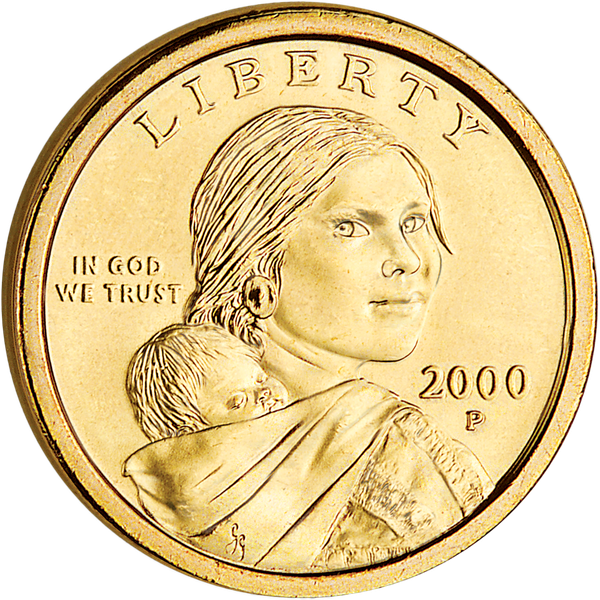
Obverse: Sacagawea – Honors the Shoshone guide born on the Idaho-Montana border who led the Lewis & Clark Expedition through the northern territory of the Louisiana Purchase to the Pacific Ocean. She met the explorers after they had arrived in North Dakota in October of 1804 and built Fort Mandan. On February 11, 1805, Sacagawea gave birth to a son, Jean Baptiste Charbonneau. Then, on April 7, she, her husband who was a fur trapper, and their infant son joined the expedition to help lead it on its westward trek.
Shoshone tribal member Randy'L He-dow Teton of Idaho was the model for the three-quarter profile of Sacagawea, who is shown holding Jean Baptiste. The obverse includes the inscriptions of liberty and in god we trust, plus the date and mint mark.
Designer & Sculptor: Glenna Goodacre
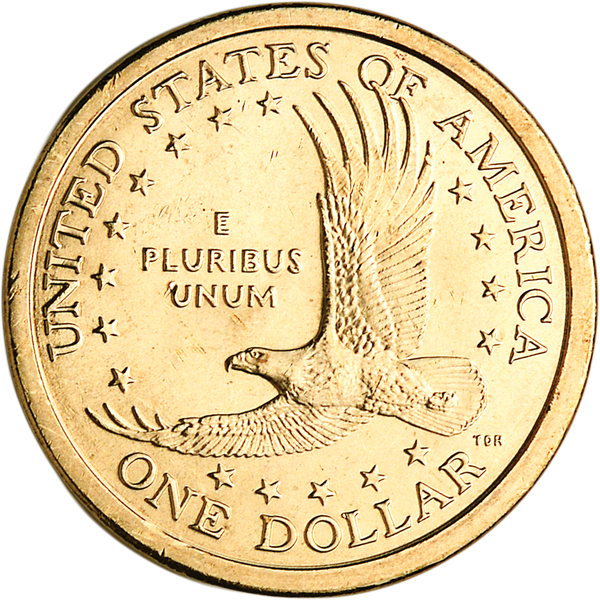
Reverse: Sacagawea – A soaring eagle is surrounded by 17 stars for the number of states in the union in 1804. The design includes united states of america, the U.S. motto in Latin e pluribus unum (Latin for "out of many, one") and the denomination: one dollar.
Designer & Sculptor: Thomas D. Rogers, Sr., a Mint engraver
Native American Dollar Designs (2009-Date)
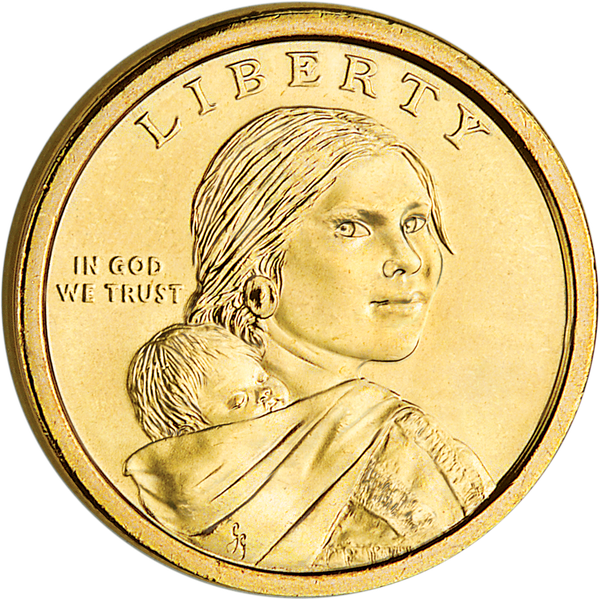
Obverse: Sacagawea (2009-Date) – The Native American dollar series continues the Sacagawea obverse design of 2000-2008. However, the date and mint marks have been moved to the coin’s edge (along with the motto in god we trust, which appeared on the Sacagawea dollar’s reverse).
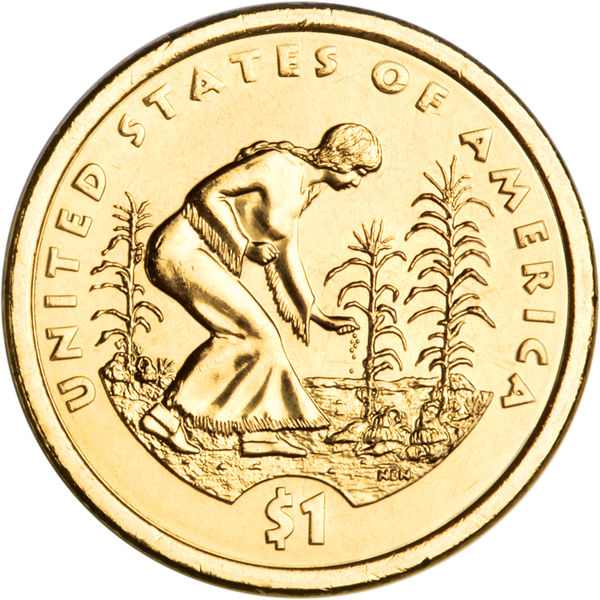
Reverse: 2009 Three Sisters – Honors the Three Sisters, a method of companion farming developed by Indigenous Peoples in which corn stalks provide a framework on which bean tendrils can grow. Beans add nitrogen to the soil, which helps corn and squash grow. The foliage of squash gourds blocks heat, retains moisture, and suppresses weeds.
Designed by sculptor-engraver Norman E. Nemeth
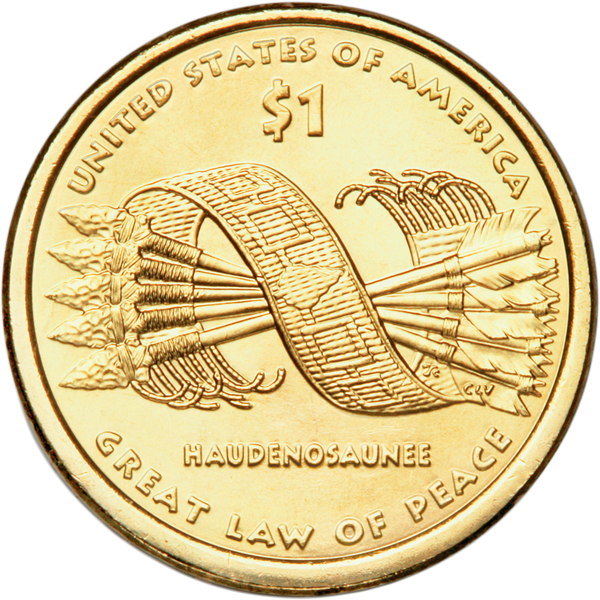
Reverse: 2010 Great Law of Peace – Honors the peace treaty of the Haudenosaunee (pronounced: ho-dee-no-SHOW-nee) Confederation. It also was known as the Iroquois Confederacy, and was largely located in upstate New York. Five arrows encircled by the Hiawatha Belt represent the five tribal nations: Mohawk, Oneida, Onondaga, Cayuga, and Seneca. Their promise of peace was sealed in the early 1400s with the symbolical burial of weapons at the foot of a Great White Pine. Hiawatha was the Peacemaker's aide who helped spread peace among the tribes.
Designed by Thomas R. Cleveland, AIP
Sculpted by Charles L. Vickers, Engraver
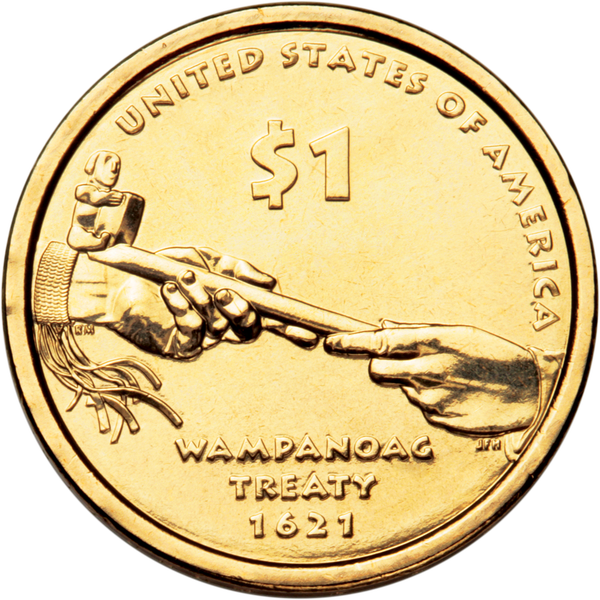
Reverse: 2011 Wampanoag Treaty – Honors the 1621 peace treaty between European settlers of Plymouth Colony and the Wampanoag Confederacy. The hands on either end of the ceremonial peace pipe represent Massasoit Sachem Ousamequin (pronounced O-saw-meh-quin) and Governor John Carver (right).
Designed by Richard Masters, AIP Master Designer
Sculpted by Joseph Menna, Chief Engraver
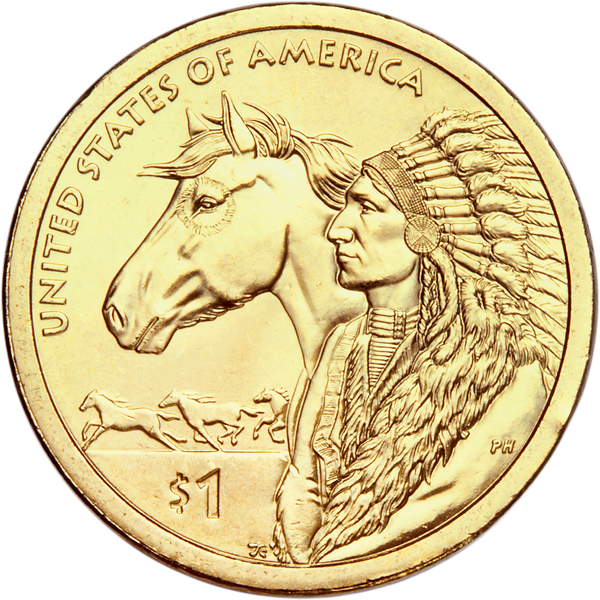
Reverse: 2012 Trade Routes – Celebrates 17th century trade routes developed by Native Americans who used horses to transport raw and finished goods by land.
Designed by Thomas Cleveland, AIP Master Designer
Sculpted by Phebe Hemphill, Medallic Artist
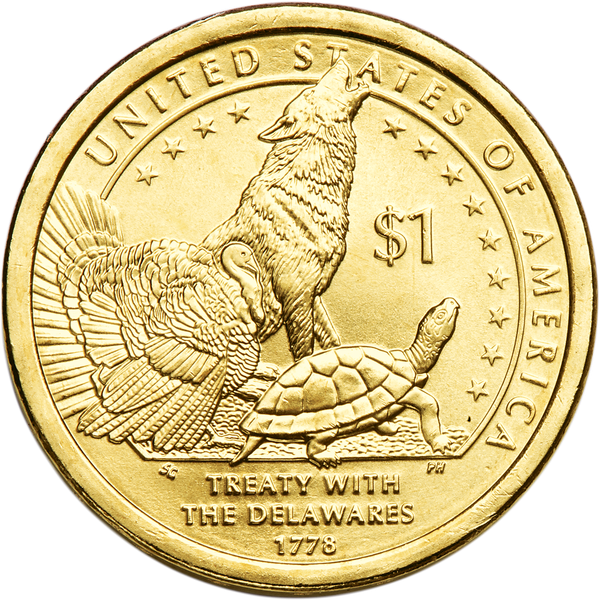
Reverse: 2013 Delawares Treaty – Honors 1778 peace treaty with the Delaware Nation that was the first Indigenous accord with the U.S. government. It was signed at Fort Pitt (now Pittsburgh, PA). Based on matrilineal lines, the Delaware clans are represented by a turtle for the Unami, a turkey for the Unlatching and a wolf for the Munsee. A ring of 13 stars represents the original colonies.
Designed by Susan Gamble, AIP Master Designer
Sculpted by Phebe Hemphill, Medallic Artist
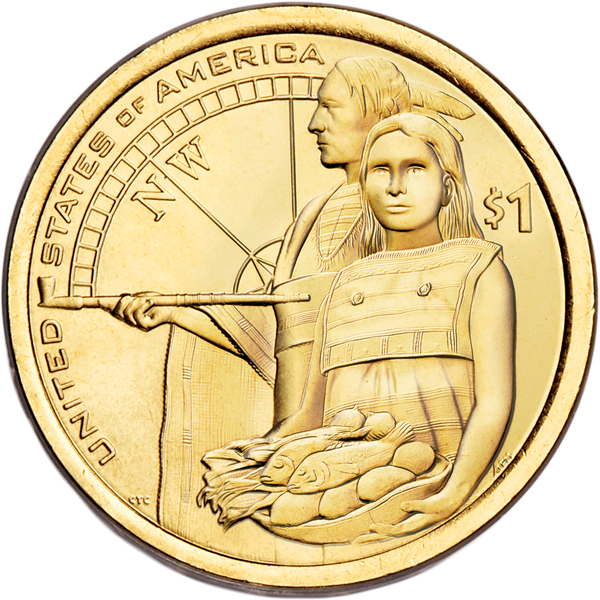
Reverse: 2014 Native Hospitality – Honors Native American hospitality shown the Lewis & Clark Expedition as it crossed the Continental Divide over the crest of the Rocky Mountains. The man presents a pipe and his wife offers fish, corns, roots and gourds. In the background is a stylized NW, for the Northwest compass point.
Designed by Chris Costello, AIP
Sculpted by Joseph Menna, Chief Engraver
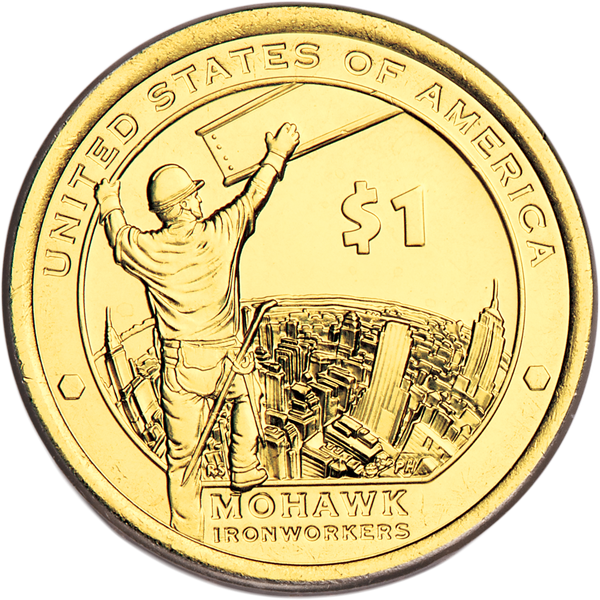
Reverse: 2015 Mohawk Ironworkers – Honors the Mohawk of the Iroquois Confederacy, whose fearlessness translated into high-rise construction employment for more than 200 years. They earned a reputation for skillful steel and iron work, erecting such iconic New York City towers as the Empire State and Chrysler Buildings, the George Washington Bridge across the Hudson River, and the original World Trade Center, plus its replacement, which opened in 2014.
Designed by Ronald D. Sanders, AIP
Sculpted by Phebe Hemphill, Medallic Artist
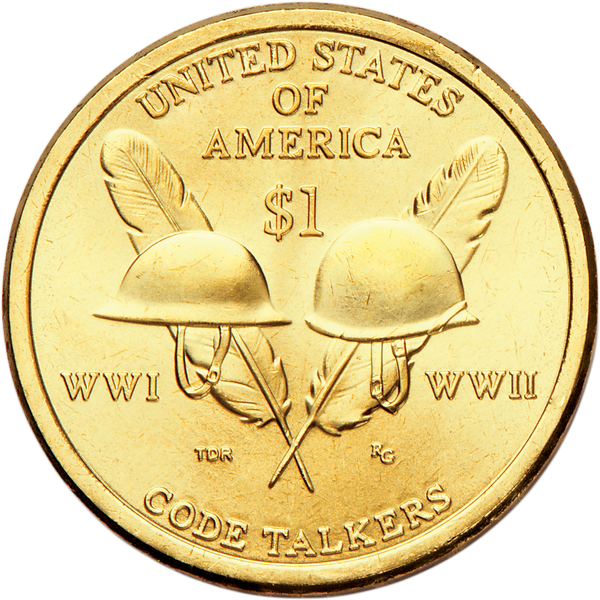
Reverse: 2016 Code Talkers – Honors World Wars I and II Code Talkers from 14 different Native American nations, who used their language skills to create secret battle codes that led to success in both world wars. The feathers form a “V” to symbolize victory; each war is represented by a different helmet design.
Designed by Thomas D. Rogers, Sr.
Sculpted by Renata Gordon, Medallic Artist
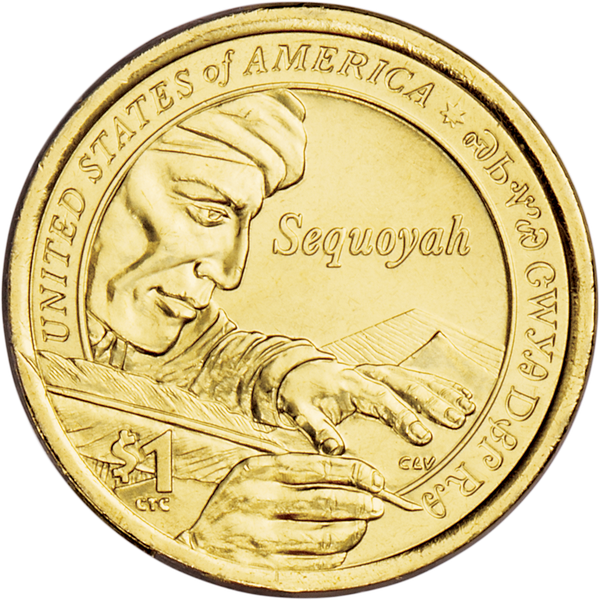
Reverse: 2017 Sequoyah – Honors Sequoyah, a member of the Cherokee Nation, and the Syllabary of 86 written symbols representing Cherokees’ spoken language, or syllables, he created in 1809. He believed a written system would increase his nation’s knowledge and help maintain its independence.
Designed by Chris Costello, AIP
Sculpted by Charles L. Vickers, Engraver
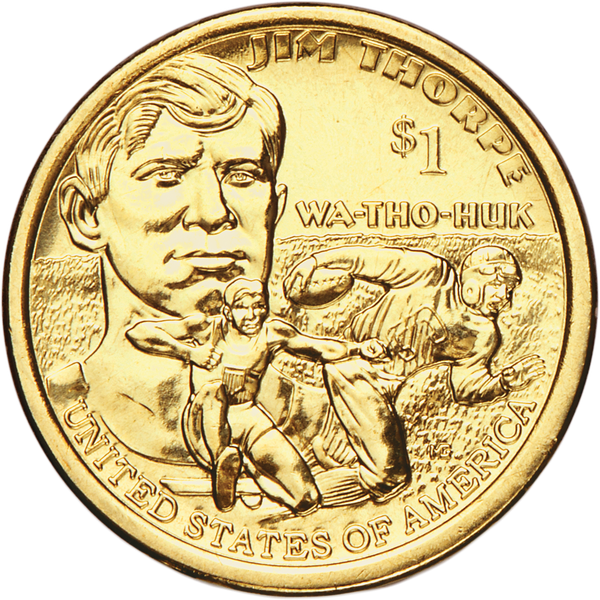
Reverse: 2018 Jim Thorpe – Honors Jim Thorpe of the Sac and Fox Nation. He was a versatile athlete who played professional football, won two gold medals in the 1912 Summer Olympics (classic pentathlon and decathlon) and was the first Native American to win Olympic gold for the United States. Design includes his tribal name, wa-tho-huk.
Designed and sculpted by Michael Gaudioso, Medallic Artist
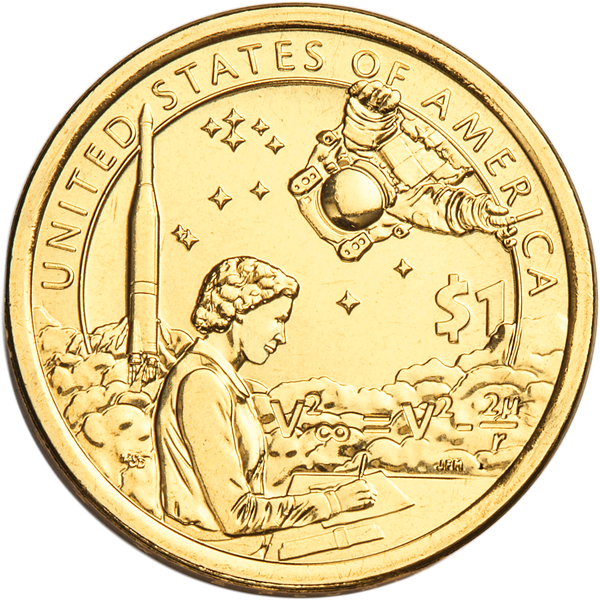
Reverse: 2019 American Indians in Space – Honors Native American contributions to the United States' space exploration program with a profile of Cherokee Mary Golda Ross, an engineer, writing calculations related to orbital mechanics. The reverse includes the Atlas-Agena rocket that took astronauts into space using some of those calculations, and a spacewalking astronaut representing all Native American astronauts, including Chickasaw John Herrington.
Designed by Emily Damstra, AIP
Sculpted by Joseph Menna, Chief Engraver
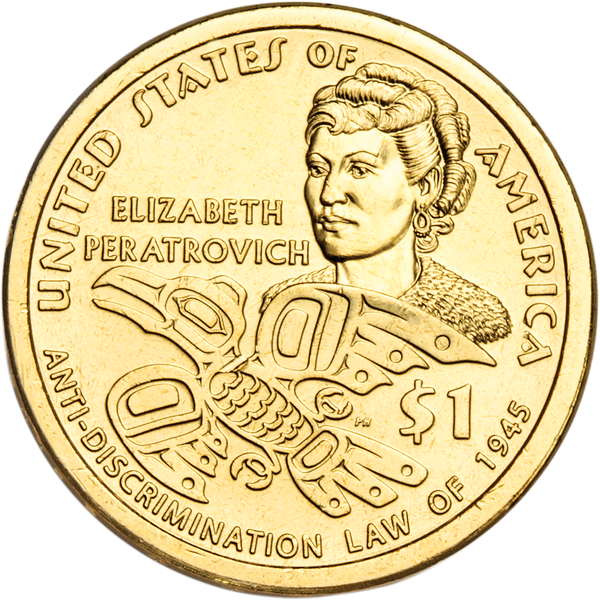
Reverse: 2020 Elizabeth Peratrovich – Honors Elizabeth Peratrovich, a member of the Raven clan of the Tlingit Nation who was instrumental getting the territorial legislature of Alaska to pass a landmark anti-discrimination law in 1945.
Designed and sculpted by Phebe Hemphill, Medallic Artist
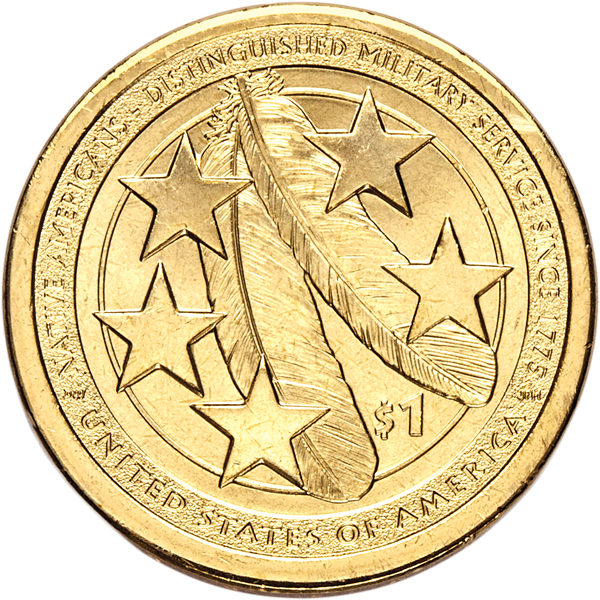
Reverse: 2021 American Indians in the Military – Honors Native Americans’ commitment to a strong military for defending our freedoms as early as the American Revolution. The reverse features a pair of eagle feathers that are traditionally earned in battle or by performing a brave deed. The stars represent five branches of the U.S. Military.
Designed by Donna Weaver, AIP
Sculpted by Joseph Menna, Chief Engraver
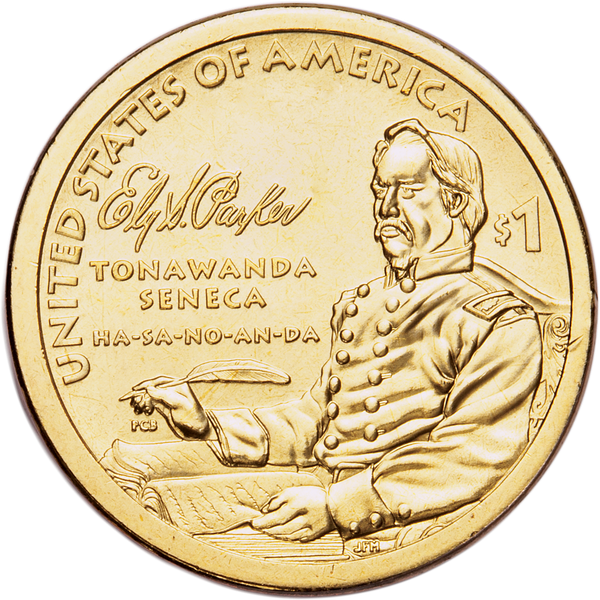
Reverse: 2022 Ely Samuel Parker – Honors Ely S. Parker of the Seneca Nation, who was a tribal diplomat and Union Army officer who served as a military aide to Ulysses S. Grant during the Civil War. When Robert E. Lee surrendered at Appomattox, VA, in 1865, Parker rendered the formal surrender documents in his own hand. The inscriptions tonawanda seneca and ha-sa-no-an-da acknowledge his tribe and name given to him at birth.
Designed by Paul C. Balan, AIP
Sculpted by Joseph Menna, Chief Engraver
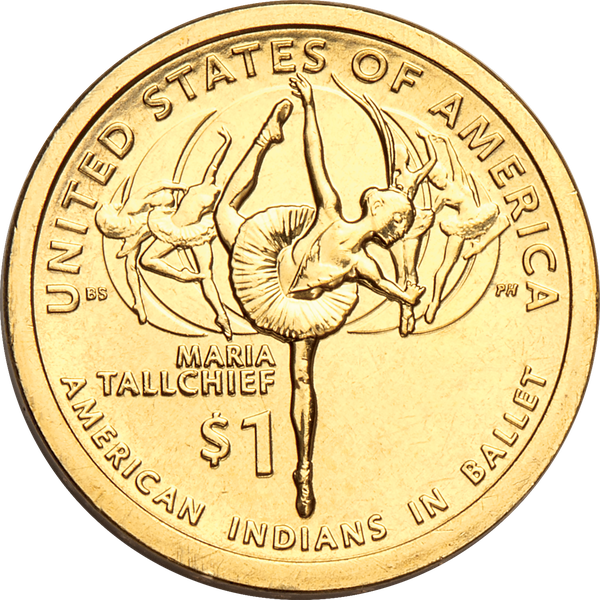
Reverse: 2023 Maria Tallchief and American Indians in Ballet – Honors the Native American ballet dancers from Oklahoma who were known as the Five Moons. They broke racial barriers in ballet during the mid-20th century. Our country’s first internationally recognized prima ballerina, Maria Tallchief of the Osage Nation, poses on pointe in front of the other four. They were Osage Marjorie Tallchief (her sister), Shawnee Yvonne Chouteau, Choctaw Rosella Hightower and Shawnee-Peoria Moscelyne Larkin.
Designed by Ben Sowards, AIP
Sculpted by Phebe Hemphill, Medallic Artist
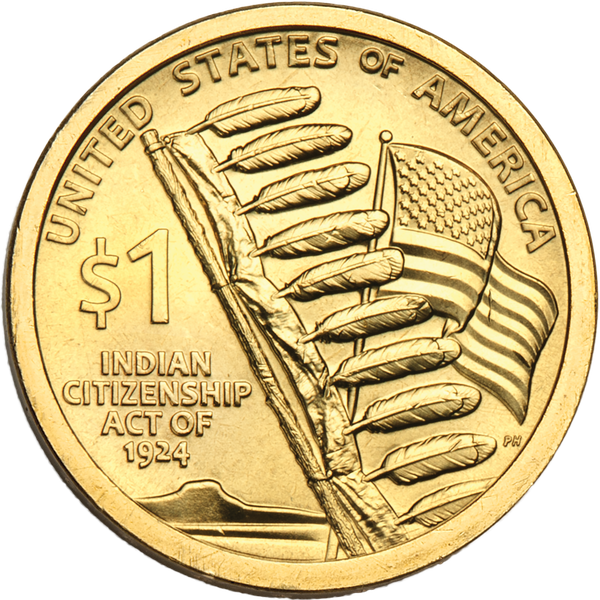
Reverse: 2024 Indian Citizenship Act of 1924 – Honors the centennial of the passage of the Indian Citizenship Act of 1924. Its central motif is an eagle staff – a Native American symbol of respect and honor – paired with a U.S. flag to represent the dual citizenship granted Native Americans.
Designed and sculpted by Phebe Hemphill, Medallic Artist
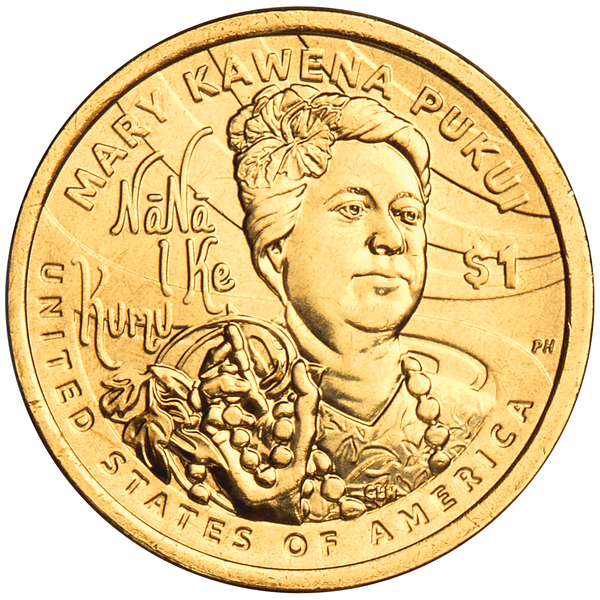
Reverse: 2025 Mary Kawena Pukui – Honors Native Hawaiian scholar Mary Kawena Pukui of Polynesian descent (also known as Pacific Islander). She is depicted wearing a hibiscus flower, a kukui nut lei (which she holds in her hand), and a muʻumuʻu adorned with an aloha print. Stylized waves of water appear in the background. Inscriptions include nānā i ke kumu, which translates as "Look to the Source" – a series of heritage books to which Pukui contributed insights on Hawaiian cultural practices, concepts and beliefs illustrating the wisdom and dignity of Native Hawaiians.
Designed by Christina Hess, AIP
Sculpted by Phebe Hemphill, Medallic Artist

